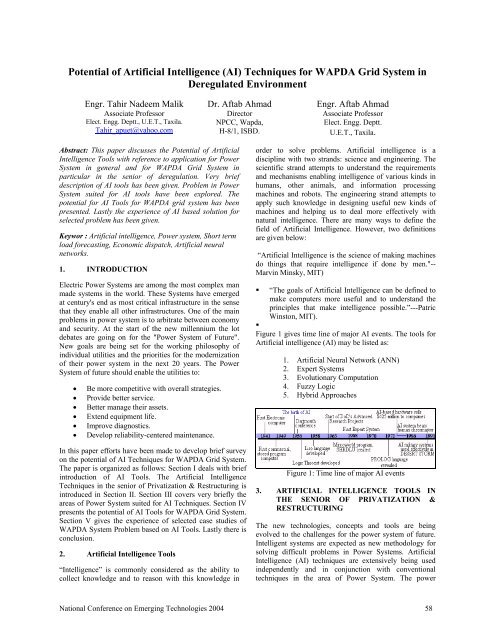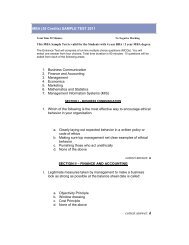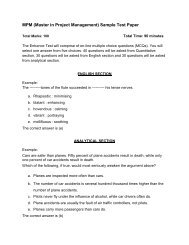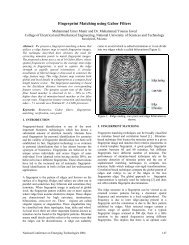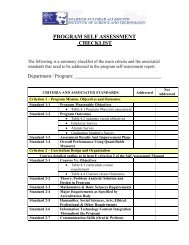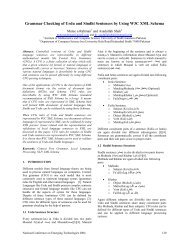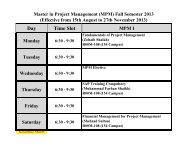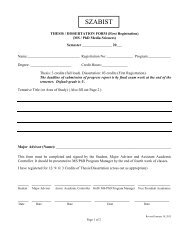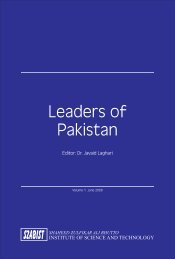Potential of Artificial Intelligence (AI) Techniques for ... - CiteSeerX
Potential of Artificial Intelligence (AI) Techniques for ... - CiteSeerX
Potential of Artificial Intelligence (AI) Techniques for ... - CiteSeerX
Create successful ePaper yourself
Turn your PDF publications into a flip-book with our unique Google optimized e-Paper software.
<strong>Potential</strong> <strong>of</strong> <strong>Artificial</strong> <strong>Intelligence</strong> (<strong>AI</strong>) <strong>Techniques</strong> <strong>for</strong> WAPDA Grid System in<br />
Deregulated Environment<br />
Engr. Tahir Nadeem Malik<br />
Associate Pr<strong>of</strong>essor<br />
Elect. Engg. Deptt., U.E.T., Taxila.<br />
Tahir_apuet@yahoo.com<br />
Dr. Aftab Ahmad<br />
Director<br />
NPCC, Wapda,<br />
H-8/1, ISBD.<br />
Engr. Aftab Ahmad<br />
Associate Pr<strong>of</strong>essor<br />
Elect. Engg. Deptt.<br />
U.E.T., Taxila.<br />
Abstract: This paper discusses the <strong>Potential</strong> <strong>of</strong> <strong>Artificial</strong><br />
<strong>Intelligence</strong> Tools with reference to application <strong>for</strong> Power<br />
System in general and <strong>for</strong> WAPDA Grid System in<br />
particular in the senior <strong>of</strong> deregulation. Very brief<br />
description <strong>of</strong> <strong>AI</strong> tools has been given. Problem in Power<br />
System suited <strong>for</strong> <strong>AI</strong> tools have been explored. The<br />
potential <strong>for</strong> <strong>AI</strong> Tools <strong>for</strong> WAPDA grid system has been<br />
presented. Lastly the experience <strong>of</strong> <strong>AI</strong> based solution <strong>for</strong><br />
selected problem has been given.<br />
Keywor : <strong>Artificial</strong> intelligence, Power system, Short term<br />
load <strong>for</strong>ecasting, Economic dispatch, <strong>Artificial</strong> neural<br />
networks.<br />
1. INTRODUCTION<br />
Electric Power Systems are among the most complex man<br />
made systems in the world. These Systems have emerged<br />
at century's end as most critical infrastructure in the sense<br />
that they enable all other infrastructures. One <strong>of</strong> the main<br />
problems in power system is to arbitrate between economy<br />
and security. At the start <strong>of</strong> the new millennium the lot<br />
debates are going on <strong>for</strong> the "Power System <strong>of</strong> Future".<br />
New goals are being set <strong>for</strong> the working philosophy <strong>of</strong><br />
individual utilities and the priorities <strong>for</strong> the modernization<br />
<strong>of</strong> their power system in the next 20 years. The Power<br />
System <strong>of</strong> future should enable the utilities to:<br />
• Be more competitive with overall strategies.<br />
• Provide better service.<br />
• Better manage their assets.<br />
• Extend equipment life.<br />
• Improve diagnostics.<br />
• Develop reliability-centered maintenance.<br />
In this paper ef<strong>for</strong>ts have been made to develop brief survey<br />
on the potential <strong>of</strong> <strong>AI</strong> <strong>Techniques</strong> <strong>for</strong> WAPDA Grid System.<br />
The paper is organized as follows: Section I deals with brief<br />
introduction <strong>of</strong> <strong>AI</strong> Tools. The <strong>Artificial</strong> <strong>Intelligence</strong><br />
<strong>Techniques</strong> in the senior <strong>of</strong> Privatization & Restructuring is<br />
introduced in Section II. Section III covers very briefly the<br />
areas <strong>of</strong> Power System suited <strong>for</strong> <strong>AI</strong> <strong>Techniques</strong>. Section IV<br />
presents the potential <strong>of</strong> <strong>AI</strong> Tools <strong>for</strong> WAPDA Grid System.<br />
Section V gives the experience <strong>of</strong> selected case studies <strong>of</strong><br />
WAPDA System Problem based on <strong>AI</strong> Tools. Lastly there is<br />
conclusion.<br />
2. <strong>Artificial</strong> <strong>Intelligence</strong> Tools<br />
“<strong>Intelligence</strong>” is commonly considered as the ability to<br />
collect knowledge and to reason with this knowledge in<br />
order to solve problems. <strong>Artificial</strong> intelligence is a<br />
discipline with two strands: science and engineering. The<br />
scientific strand attempts to understand the requirements<br />
and mechanisms enabling intelligence <strong>of</strong> various kinds in<br />
humans, other animals, and in<strong>for</strong>mation processing<br />
machines and robots. The engineering strand attempts to<br />
apply such knowledge in designing useful new kinds <strong>of</strong><br />
machines and helping us to deal more effectively with<br />
natural intelligence. There are many ways to define the<br />
field <strong>of</strong> <strong>Artificial</strong> <strong>Intelligence</strong>. However, two definitions<br />
are given below:<br />
“<strong>Artificial</strong> <strong>Intelligence</strong> is the science <strong>of</strong> making machines<br />
do things that require intelligence if done by men."--<br />
Marvin Minsky, MIT)<br />
• “The goals <strong>of</strong> <strong>Artificial</strong> <strong>Intelligence</strong> can be defined to<br />
make computers more useful and to understand the<br />
principles that make intelligence possible.”---Patric<br />
Winston, MIT).<br />
•<br />
Figure 1 gives time line <strong>of</strong> major <strong>AI</strong> events. The tools <strong>for</strong><br />
<strong>Artificial</strong> intelligence (<strong>AI</strong>) may be listed as:<br />
1. <strong>Artificial</strong> Neural Network (ANN)<br />
2. Expert Systems<br />
3. Evolutionary Computation<br />
4. Fuzzy Logic<br />
5. Hybrid Approaches<br />
Figure 1: Time line <strong>of</strong> major <strong>AI</strong> events<br />
3. ARTIFICIAL INTELLIGENCE TOOLS IN<br />
THE SENIOR OF PRIVATIZATION &<br />
RESTRUCTURING<br />
The new technologies, concepts and tools are being<br />
evolved to the challenges <strong>for</strong> the power system <strong>of</strong> future.<br />
Intelligent systems are expected as new methodology <strong>for</strong><br />
solving difficult problems in Power Systems. <strong>Artificial</strong><br />
<strong>Intelligence</strong> (<strong>AI</strong>) techniques are extensively being used<br />
independently and in conjunction with conventional<br />
techniques in the area <strong>of</strong> Power System. The power<br />
National Conference on Emerging Technologies 2004 58
industry has seen the extensive application <strong>of</strong> <strong>AI</strong><br />
techniques to a wide range <strong>of</strong> power system problems.<br />
Deregulation will probably be the primary <strong>for</strong>ce driving<br />
the long-term future <strong>of</strong> <strong>AI</strong> applications to power systems.<br />
Three principal features <strong>of</strong> deregulation seem likely to<br />
provide motivation <strong>for</strong> increased ef<strong>for</strong>ts to apply <strong>AI</strong><br />
<strong>Techniques</strong> to power systems.<br />
• First, uncertainty in the input data will increase.<br />
Market <strong>for</strong>ecasts will be required, and there is no<br />
reason to believe that electrical energy markets will<br />
exhibit any more predictability than do other markets.<br />
• Second, the complexity <strong>of</strong> operations will increase<br />
dramatically, as energy transactions under the<br />
purview <strong>of</strong> a control center increase by an order <strong>of</strong><br />
magnitude, each requiring technical analysis,<br />
approval, oversight, and accounting.<br />
• Finally, the time pressures associated with<br />
competitive markets seem likely to appear in power<br />
systems operations and operations planning. This is<br />
certainly true <strong>for</strong> generators, who will have to market<br />
their power, and probably also true <strong>for</strong> the<br />
transmission system, which will be pressured to make<br />
rapid decisions on the suitability <strong>of</strong> various sales.<br />
The need <strong>for</strong> fast answers to complicated problems with<br />
uncertain and incomplete data will undoubtedly grow as<br />
deregulation progresses. This situation presents an<br />
enormous opportunity <strong>for</strong> <strong>AI</strong> applications to solve the<br />
challenging problems looming in the future <strong>of</strong> power<br />
systems.<br />
4. <strong>AI</strong> TOOLS IN POWER SYSTEM<br />
Modern power systems are required to generate and<br />
supply high-quality electrical energy to consumers. The<br />
electric power industry is continuously searching <strong>for</strong> ways<br />
to improve the efficiency and reliability with which it<br />
supplies energy. Although the fundamental technologies <strong>of</strong><br />
power generation, transmission, and distribution change<br />
quite slowly, the power industry has been quick to explore<br />
new technologies that might assist its search and to<br />
wholeheartedly adopt those that show benefits.<br />
Since beginning <strong>of</strong> last decade <strong>of</strong> previous century, the<br />
researchers in the power engineering community have<br />
been studying the feasibility and application <strong>of</strong> new<br />
in<strong>for</strong>mation processing techniques <strong>for</strong> efficient problem<br />
solving <strong>of</strong> complex power system problems. With the<br />
advent <strong>of</strong> artificial intelligence tools, alternative strategies<br />
have been identified, proposed and developed <strong>for</strong> the<br />
solution <strong>of</strong> ill-structured and complex problems in power<br />
systems. The acceptance <strong>of</strong> these techniques by the power<br />
engineering community, both in the academic institutions<br />
and industry, has paved way <strong>for</strong> basic research into the<br />
identification <strong>of</strong> new methodologies in artificial<br />
intelligence and machine learning, and in an attempt to<br />
understand the basic concept <strong>of</strong> problem solving and its<br />
application to power systems [1-3].<br />
The dual questions <strong>of</strong> which problem to attack with <strong>AI</strong><br />
techniques and which <strong>AI</strong> technique to use <strong>for</strong> a particular<br />
problem are abiding ones in the power industry, as they<br />
are in many other industries.<br />
4.1 Opportunities <strong>for</strong> <strong>AI</strong> in Power Systems<br />
The typical utility's electric power system consists <strong>of</strong><br />
generation, transmission, and distribution systems.<br />
Generators produce electric power. The transmission<br />
system moves it in bulk, <strong>of</strong>ten over large distances, and<br />
the distribution system delivers it to individual customers.<br />
Even this simplified sketch <strong>of</strong> a utility illustrates several<br />
important characteristics <strong>of</strong> the problems that appear. First,<br />
problems can appear as either component or system<br />
problems. Secondly many system problems exhibit<br />
combinatorial complexity. Applications that address<br />
system-level problems must be able to deal with the<br />
number <strong>of</strong> components in the typical power system, either<br />
directly or by reducing the problem size to a manageable<br />
level without losing too much accuracy in the result. Thus<br />
power system is highly complex and nonlinear system to<br />
be solved and operated. Time scales involved <strong>for</strong> various<br />
activities in power system planning, operation and control<br />
varies from second, minutes, hours, months and years.<br />
<strong>AI</strong> tools have been useful <strong>for</strong> solving power system<br />
problems when there is a good match between the problem<br />
characteristics and those <strong>of</strong> the <strong>AI</strong> tool. One aspect <strong>of</strong><br />
power system problems, which is highly significant <strong>for</strong> <strong>AI</strong><br />
applications, is the nonlinear behavior <strong>of</strong> the various<br />
components and <strong>of</strong> the entire system.<br />
4.2 Problems suited <strong>for</strong> <strong>AI</strong> Tools<br />
To investigate which characteristics <strong>of</strong> power system<br />
problems are suited to <strong>AI</strong> tools, we can categorize the<br />
problems by time frame into real-time control, operations,<br />
operation’s planning, and planning. The brief description is<br />
as follows:<br />
Real-Time Control<br />
Real-time control involves both discrete and continuous<br />
control systems. Many real-time controls are quite simple<br />
in their individual operation, but their coordinated effect<br />
on the power system and their interactions through the<br />
power system can become quite complex<br />
Discrete Load Shedding, Protection, Trans<strong>for</strong>mer,<br />
Control<br />
Continuous<br />
Control<br />
Capacitor Switches<br />
Generator exciters<br />
Operations<br />
This category includes real-time human decision making<br />
in time frames ranging from a few minutes to several<br />
hours. SCADA provides the fuel <strong>for</strong> EMS in Control<br />
Centre. Issues to be dealt may be: Alarm Processing,<br />
AGC, Short Term Optimization, and Security.<br />
National Conference on Emerging Technologies 2004 59
Operations Planning<br />
This category deals with operating strategies <strong>for</strong> time<br />
frames ranging from a day to a year into the future.<br />
Operations planning occur in interactive environments<br />
using either the EMS or <strong>of</strong>f-line processing. The three<br />
principal focuses are economics, security, and<br />
maintenance scheduling. All require a <strong>for</strong>ecast <strong>of</strong> the<br />
loads on the power system.<br />
Planning<br />
The primary concern in power system planning is decision<br />
making <strong>for</strong> capital projects with life times measured in<br />
tens <strong>of</strong> years. Each alternative is evaluated <strong>for</strong> its security<br />
and economic impacts on the existing system. Although<br />
driven by technical issues such as load growth and<br />
generation or transmission capacity, major planning<br />
decisions dealing with new generation or new transmission<br />
lines tend to be dominated by political and financial<br />
considerations. Planning also occurs to develop procedures<br />
<strong>for</strong> shorter time frames. For example, power system<br />
blackouts occur occasionally, and generic plans are<br />
developed <strong>of</strong>f line <strong>for</strong> restoring the power system<br />
4.3 Opportunities <strong>for</strong> <strong>AI</strong> in Power System Problem<br />
Real-Time Control<br />
The power system's rich diversity <strong>of</strong> distributed real-time<br />
control functions provides many opportunities <strong>for</strong> <strong>AI</strong><br />
applications. These opportunities occur both directly in the<br />
controllers to classify monitored conditions and execute<br />
desired logic or heuristics and indirectly in solving<br />
problems complicated by the interaction <strong>of</strong> real-time<br />
controls at the system or component level<br />
Operations<br />
The EMS, with its automatic data collection,<br />
computational facilities, interface to humans in the<br />
operations control loop, and complex real-time tasks, is an<br />
attractive environment <strong>for</strong> <strong>AI</strong> tools. They can augment<br />
existing applications or provide new applications beyond<br />
the scope <strong>of</strong> traditional numerical control, analysis, and<br />
optimization applications.<br />
Operations Planning<br />
The complex problems in load <strong>for</strong>ecasting, the heuristics<br />
used in large nonlinear optimization problems, and the<br />
knowledge-intensive tasks associated with operations<br />
planning are all areas <strong>of</strong> potential <strong>AI</strong> application.<br />
5. POTENTIAL FOR <strong>AI</strong> TOOLS IN WAPDA<br />
SYSTEM<br />
The <strong>AI</strong> Tools may be applied <strong>for</strong> various problems in<br />
WAPDA Grid system. However, few applications may be<br />
listed as:<br />
Expert Systems<br />
Monitoring & Diagnosis, Restoration, Security, Load<br />
Forecasting, Voltage Control.<br />
<strong>Artificial</strong> Neural Networks<br />
Load Forecasting, Unit commitment, Economic Dispatch,<br />
Security<br />
Evolutionary Computation<br />
Unit Commitment, Economic dispatch, Security<br />
Hybrid Approaches<br />
Economic dispatch, Unit commitment<br />
6. <strong>AI</strong> TOOLS APPLICATION IN WAPDA SYSTEM<br />
Three case studies have been presented in this section to<br />
highlight the experience <strong>of</strong> using <strong>AI</strong> Tools with WAPDA<br />
System problems.<br />
Economic Dispatch Using Analytic Hopfield Neural<br />
Network<br />
Case Study I<br />
Economic Dispatch Problem (EDP) has been solved using<br />
Analytic Hopfield Method [5]. Both λ iteration and<br />
Analytic Hopfield Models have been programmed in<br />
Visual C environment Table 1 gives the comparison <strong>for</strong><br />
the three machine test system [6] Comprehensive<br />
discussion on ANN based advances in Economic dispatch<br />
can be referred in [7]. EDP <strong>of</strong> simplified WAPDA system<br />
has also been carried out. Table 2 lists the results.<br />
Case Study -II<br />
Short Term Load Forecasting <strong>for</strong> WAPDA System Using<br />
<strong>Artificial</strong> Neural Network<br />
In order to apply the ANN to Wapda System Short Term<br />
Load Forecasting problem, back propagation algorithm<br />
has been programmed in C++ language. Real data <strong>of</strong><br />
Wapda system <strong>for</strong> the years 1091-92 & 1999-2000 has<br />
been used to train the network and then <strong>for</strong>ecast was made<br />
<strong>for</strong> the year 1993 & 2003 respectively. The <strong>for</strong>ecasted<br />
results then compared with the real and actual load <strong>of</strong> the<br />
Wapda system <strong>for</strong> the same period. The methodology<br />
adopted is as follows:<br />
1. The whole year has been divided into three seasons ---<br />
Summer (From May – September) Winter (From<br />
November – February) Spring (From March – April)<br />
2. Target: Prediction <strong>of</strong> peak load over the day<br />
3. Inputs: Three inputs --- Previous day peak load in<br />
MW, Previous week peak load in MW Previous<br />
month peak load in MW<br />
Tables 3, 4 & 5 list the result <strong>of</strong> summer season 1993,<br />
winter season 2001 & spring season 2001 (with η as<br />
momentum and α as learning rate) respectively.<br />
7. CONCLUSION<br />
In the deregulated environment quick decision making is a<br />
vital parameter. The <strong>AI</strong> tools can be exploited <strong>for</strong> the<br />
National Conference on Emerging Technologies 2004 60
solution <strong>of</strong> the various problem <strong>of</strong> WAPDA Grid System.<br />
The case studies highlight the experience with WAPDA<br />
system. <strong>AI</strong> Tool based solution could be effective and<br />
useful option in the new millennium <strong>for</strong> WAPDA Grid<br />
System.<br />
Table 1.EDP Comparison <strong>of</strong> Analytical Hopfield Neural<br />
Network with Lambda Iteration<br />
Analytic Lambda Iteration<br />
HFNN<br />
with Pm ∆λ<br />
= 0.01 Specified<br />
∆λ<br />
Gradient<br />
Method<br />
P1 393.1653 393.4365 393.1696<br />
P2 334.6000 334.4128 334.6036<br />
P3 122.224 122.1496 122.226<br />
Total<br />
Power<br />
Generated<br />
849.99 849.999 849.999<br />
Power 0.009 0.001 0.0003<br />
Mismatch<br />
No. <strong>of</strong> 1 147523 02<br />
Iteration<br />
Lambda --- 9.137 9.148<br />
Total Cost <strong>of</strong><br />
Generation<br />
8189.126 8194.0237 8194.3561<br />
Table 2.EDP <strong>of</strong> WAPDA System Comparison <strong>of</strong><br />
Analytical Hopfield Neural Network with Lambda<br />
Iteration<br />
Analytic<br />
HFNN<br />
with Pm<br />
= 0.01<br />
Lambda Iteration<br />
∆λ<br />
Gradient<br />
Method<br />
∆λ<br />
Specified<br />
P1 200 200 200<br />
P2 200 200 200<br />
P3 100 100 100<br />
P4 50 50 50<br />
P5 200 200 200<br />
P6 537.837 537.838 537.837<br />
P7 500 500 500<br />
P8 200 200 200<br />
P9 512.162 512.162 512.162<br />
P10 800 800 800<br />
P12 500 500 500<br />
P13 2200 2200 2200<br />
Total<br />
Power<br />
Generated<br />
6000 6000 6000<br />
Power 0.001 0.000 0.00<br />
Mismatch<br />
No. <strong>of</strong> 10 6 821892<br />
Iteration<br />
Lambda - 20.21892 20.21891<br />
Total Cost<br />
<strong>of</strong><br />
Generation<br />
64133.493 64133.5135 64133.494<br />
Table 3 Actual & Forecast Load <strong>for</strong> Winter Season 2001<br />
<strong>for</strong> WAPDA System with η = 0.24 & α = 0.6<br />
Forecast Actual Forecast % Error<br />
Date load load<br />
28.9.1993 6414 6833 6.5<br />
21.9.1993 6544.7 6484 0.92<br />
14.9.1993 5979.7 5987 0.12<br />
7.9.1993 6061.5 6137 1.2<br />
31.8.1993 5813.1 6594 0.13<br />
24.8.1993 6265.5 6133 2.11<br />
17.8.1993 6203.5 6306 1.6<br />
10.8.1993 6259.1 6242 0.27<br />
3.8.1993 6006.8 6274 4.4<br />
27.7.1993 6320.7 6477 2.4<br />
20.7.1993 6176.7 6202 0.40<br />
13.7.1993 6233.1 6237 0.06<br />
6.7.1993 6237.5 6308 1.13<br />
29.6.1993 6030.4 5998 0.53<br />
22.6.1993 5835.9 5933 1.6<br />
15.6.1993 5502 5108 7.16<br />
8.6.1993 6137 5946 3.11<br />
1.6.1993 5669 5698 0.51<br />
25.5.1993 5868 6146 4.73<br />
18.5.1993 5735 5722 0.22<br />
11.5.1993 5557.9 5673 1.71<br />
4.5.1993 5863.3 5872 0.14<br />
Average percentage error = 1.86%<br />
Maximum percentage error = 6.53%<br />
Minimum percentage error = 0.06%<br />
Table 4 Actual & Forecast Load <strong>for</strong> Winter Season 2001<br />
<strong>for</strong> WAPDA System with η = 0.27 & α = 0.96<br />
Forecast Actual Forecast % Error<br />
Date load load<br />
27.2.2001 7832 7615 2.77<br />
20.2.2001 7616 7533 1.08<br />
13.2.2001 7822 7592 2.94<br />
6.2.2001 7904 7637 3.37<br />
30.1.2001 7792 7590 2.59<br />
23.1.2001 8085 7706 4.68<br />
16.1.2001 7793 7578 2.75<br />
9.1.2001 8256 7756 6,05<br />
2.1.2001 7947 7690 3.23<br />
Average percentage error = 3.27<br />
Maximum percentage error = 6.05<br />
Minimum percentage error = 1.08<br />
Table 5 Actual & Forecast Load <strong>for</strong> Spring Season 2001<br />
<strong>for</strong> WAPDA System with η = 0.25 & α = 0.97<br />
Forecast Actual Forecast % Error<br />
Date load load<br />
25.4.2001 8719 8275 5.09<br />
19.4.2001 7302 7414 1.5<br />
11.4.2001 8494 8283 2.48<br />
4.4.2001 7767 7856 1.14<br />
28.3.2001 7228 7605 5.21<br />
21.3.2001 8011 8185 2.17<br />
14.3.2001 8241 8150 1.10<br />
7.3.2001 7192 7397 2.85<br />
Average percentage error = 2.65<br />
Maximum percentage error = 5.09<br />
Minimum percentage error = 1.5<br />
National Conference on Emerging Technologies 2004 61
REFERENCES<br />
[1]. Z. Z. Zhang, G. S. Hope, O.P. Malik, Expert<br />
System in Electric power Systems--- A<br />
Bibliographic Survey, IEEE Transactions on Power<br />
System, 4(4): 1355-1362, Oct. 1989. Vol 4, No.4.<br />
[2]. By Raj Aggarwal and Yonghua Song, <strong>Artificial</strong><br />
Neural Networks in Power Systems Part 1 General<br />
Introduction to Neural Computing, IEE Power<br />
Engineering Journal, 11(3): 129-134, June 1997.<br />
[3]. Raj Aggarwal and Yonghua Song, <strong>Artificial</strong> Neural<br />
Networks in Power Systems Part 2 Types <strong>of</strong><br />
<strong>Artificial</strong> Neural Networks, IEE Power Engineering<br />
Journal, 12n (1):41-47, February 1998.<br />
[4]. Raj Aggarwal and Yonghua Song, <strong>Artificial</strong> Neural<br />
Networks in Power Systems Part 3 Examples <strong>of</strong><br />
Applications in Power Systems, IEE Power<br />
Engineering Journal, 12(6):279-287, December<br />
1998.<br />
[5]. Ching-Tzong Su, Gwo-Jen Chiou, A Fast-<br />
Computation Hopfield Method to Economic<br />
Dispatch <strong>of</strong> Power Systems, IEEE Transactions on<br />
Power Systems, 12(4):1759-1764, November 1997.<br />
Vol. 12, No. 4, pp.1759-1764.<br />
[6]. Allen J. Wood, Power Generation Operation and<br />
Control. John Wiley & sons, Inc., 1996.<br />
[7]. Tahir Nadeem Malik, Dr. Aftab Ahmad, and Aftab<br />
Ahmad, “ A Review <strong>of</strong> advances in economic<br />
dispatch using artificial neural network”, In<br />
Proceedings to the f First International Conference<br />
on In<strong>for</strong>matics in Control, Automation and<br />
Robotics-ICINCO 2004, pages 354-357, Setubal,<br />
Portugal, August, 2004.<br />
National Conference on Emerging Technologies 2004 62


